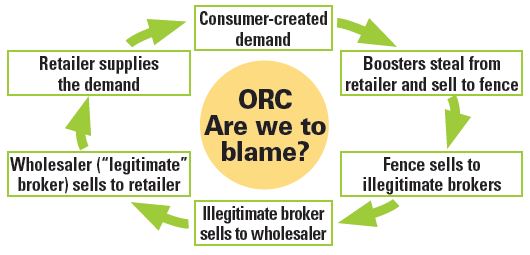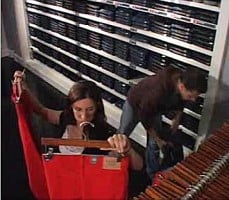You may be exhausted from hearing all the bad news regarding organized retail crime (ORC). Sure, we hear about large arrests made on organized retail crime rings, but we all know that as soon as one ring is dismantled, the power vacuum sucks in the next in line to open up shop in its place. Are we truly making the level of progress that we have all hoped?
A 2011 article in the Star Tribune stated, “While retailers spend $12 billion a year to battle organized retail crime, thieves pilfer $30 billion annually, a huge blow to businesses and, ultimately, their customers.” If these data are correct, then it’s official—we are losing the war against organized retail crime.
This is perplexing given that our profession has never had more resources available to it than it does today. We have vendor partners who have diligently sought to acquire, develop, and improve upon technologies to help us do our jobs more efficiently. We continue to invest in state-of-the-art equipment and technology, specialized personnel for undercover operations, training seminars, books, meetings, and committees. We are even seeing legislation enacted all across the country that addresses organized retail crime, thanks to the lobbying efforts of LP professionals.
Armed with these resources, we have collectively taken up arms, mounted our horses, and staged an all-out assault on criminals who use Internet sites, flea markets, cleaning houses, warehouses, and even illegitimate brick-and-mortar storefronts to move the stolen goods. All of this with one objective in mind—stopping professional thieves from removing mass quantities of merchandise from our stores. With all of these deployed resources, how can we still be losing this war on organized retail crime?
It is possible that while we are all focused on preventing our merchandise from leaving through the front doors of our respective castles of commerce, we never once considered what was coming in through our back doors. Could it be that we have been hitting the bulls-eye of the wrong target?
Economics of Organized Retail Crime
 Before we answer this question, let’s first consider the “economics of organized retail crime.” We all understand that boosters are part of a complex business enterprise. But even though these are illegitimate businesses, they still operate under the same indiscriminate economic principle of supply and demand. No retailer or wholesaler can stock their shelves with merchandise no one wants and expect to be successful. Similarly, no retailer or wholesaler can sell merchandise they don’t have. Said differently, the supply of a product and the demand for that same product must have a synchronized relationship in order for an enterprise to profitably function.
Before we answer this question, let’s first consider the “economics of organized retail crime.” We all understand that boosters are part of a complex business enterprise. But even though these are illegitimate businesses, they still operate under the same indiscriminate economic principle of supply and demand. No retailer or wholesaler can stock their shelves with merchandise no one wants and expect to be successful. Similarly, no retailer or wholesaler can sell merchandise they don’t have. Said differently, the supply of a product and the demand for that same product must have a synchronized relationship in order for an enterprise to profitably function.
So how does supply and demand play a role in our fight against organized retail crime? If we as loss prevention professionals were asked where stolen merchandise was being sold, the majority of us might tend to say Internet sites, flea markets, and a whole host of other locations. And why not? Every ORC ring that has ever been conquered has been identified as using one or more of these venues. However what if we, as retailers, are unknowingly purchasing the very merchandise that was stolen from our shelves just a few weeks earlier? What if we are actually causing the “demand” needed for the supply-and-demand principle to work?
Consider for a moment what is occurring right under our noses. Boosters steal our merchandise and sell it to a fence. The fence cleans and organizes the cache into two categories—pristine and damaged. The damaged, or marked, merchandise goes to the all-too-familiar flea markets and Internet sites, but the pristine items are sent up the chain where they eventually land in a repack operation. Once there, our stolen merchandise is packed in boxes labeled with the same quality names of the manufacturers with whom we do business.
The stolen merchandise, now packed neatly into branded boxes, is sent to wholesalers. Some wholesalers may be aware the merchandise is suspect and others may not, but either way they have plausible deniability. These wholesalers accept this merchandise into their inventory waiting for a buyer to place an order. If that buyer happens to be a broker representing your company, then your company just created the demand for more merchandise to be stolen. The chart above will help demonstrate this point.
Anti-ORC Buying Program
The only way to stop organized retail crime is to stop the demand. As loss prevention professionals, we have a duty to build an anti-ORC buying program for our organizations. Here are suggestions for approaching this challenge:
Step 1—Meet with your executives and explain how buying stolen product creates demand for more stolen product.
Step 2—Get a commitment that your company will not purchase stolen product, which may entail revamping incentive structure for buyers.
Step 3—Communicate expectations to suppliers by establishing procedures for violations and sending vendors detailed letters.
Step 4—Create a “right to audit” clause in all supplier contracts that allows unannounced visits to supply warehouses.
Step 5—Audit for compliance by inspecting lot numbers after you receive product.
If retailers only purchased merchandise from legitimate suppliers, then wholesalers will be forced to stop buying stolen product. If the illegitimate sources lose the customers to whom they’ve been selling stolen product, then the stolen merchandise will no longer have value.
We will always be fighting the sale of stolen merchandise at flea markets and the like, but if we all ban together and build an effective anti-ORC buying program for our respective organizations, the losses will drastically decrease to such a level that we can finally use our progress and resources on more profitable challenges.
For more on the subject, check out “How NOT to Investigate Organized Retail Crime.”
This article was first published in 2012 and updated August 11, 2016.


